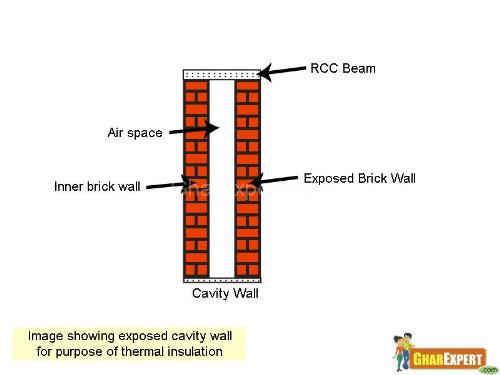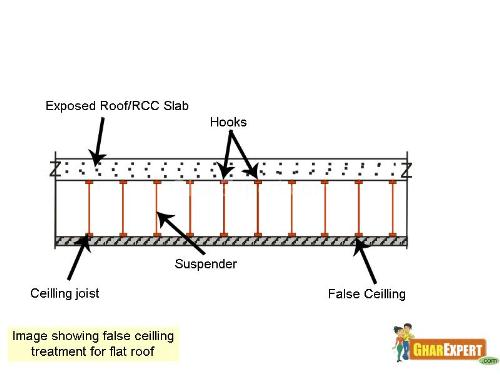Thermal insulation is a method to reduce the transfer of heat from outside to inside. To make house heat proof,
thermal insulation is a good choice. An insulated home is more
comfortable as the temperature remains consistent over weather changes.
It makes the house comfortable and keeps the temperature of house cool in summers and warm in winters. It is very useful to keep the temperature of the house independent from outside temperature.
General Principles of Thermal Insulation
• Thermal resistance of an insulating material depends on the type of material and the thickness.
• Provision of an air gap is very important and useful insulating agent.
•
Orientation of the building has important role in thermal resistance.
•
The
building/house design is done in such a way so that entry of solar
energy in summer should be minimum and in winter it should be maximum.

Choice of Insulating Materials
Choice of insulating material depends on following considerations.
•
Cost of insulating material.
• Area to be covered for insulation.
• Standard of insulation to be required.
• Cost of energy consumed for heating and cooling.
• Reasonable fire proof
• Non absorbent of moisture
• Not liable to undergo deformation
• Resistant to attack of small insects
Insulating Material
1. Rock wool.
2. Slag slabs
3. Mineral wool slabs
4. Aluminum foils
5. Cement concrete block with lightweight aggregate.
6. Gypsum board
7. Asbestos cement board
8. Clip board
9. ACC cement board
10. Chip board
11. Foam glass
12. Gasket cork sheet, foam plastic etc.
How to apply insulating material
Apply
CPRX compound of Shalimar Tar Products (STP) on ceiling of roof. For
fiberglass or glass wool insulation, you can fix 2" thick pieces. For
Thermocol or rubber foam, you can fix 2'X2' pieces. These can also be
fixed into wooden frames 2' X2' size. Finally, cover the treatment with
24 gauze perforated aluminum panel.
How Thermal Insulation is Beneficial
•
Comfort: The
temperature of the room remains cool in summer and warm in winter
than that of outside atmosphere. Therefore, by providing thermal
insulation one feels comfort both in summer and winter season.
•
Fuel saving:
Fuel is required to maintain desired temperature of the room. By
providing thermal insulation, the transfer of heat/cold reduces between
inside and outside of the room.. Hence, it saves fuel.
•
Condensation Resistant:
Thermal insulation materials fixed on inside surface of the room walls
prevent condensation on interior walls and ceiling. Condensation is
deposition of moisture and takes place when warm air comes in contact of
surface having temperature below dew point.
Thermal Insulation of Exposed Walls
The heat and cold radiate through exposed walls of the house. There
are following methods of thermal insulation of exposed walls.
1. You may provide suitable thickness of wall.
2. You may provide Hallow wall or cavity wall.
3. You may fix Hardboards or ply board on wooden batten over the wall for creating air space.
4. You may fix Thermal insulating material sheet inside and outside exposed wall to reduce heat/cold transmission.
5. You may construct outer wall with thermal insulating material if you have frame structural building or non-load bearing walls.


Thermal Insulation of Exposed Doors and Windows
Outside doors and windows transmit heat/cold through the room from
atmosphere. The methods providing thermal insulation are following.
1. The frames of doors and windows are of wood.
2. You should not use Iron or pressed steel frames as they transmit more heat and cold than that of wood.
3. You may fix Insulated glass in glazed doors and windows.
4. Double glass with air space provided on glazed door will reduce transmission of heat/cold from outside to inside.
5. You may provide sunshade projection on doors and windows to protect them from heat and rain.
6. You may use Curtains, ventilation blends etc. on exposed doors and windows.
Thermal Insulation of Exposed Roof
The roof of the one storey building or top roof of multi storey
building is an exposed roof. Heat/cold transmits through exposed roof in
the building. There are two types of treatment for thermal insulation
of exposed roof by providing treatment at the bottom or top of roof
slab.
a) Internal Treatment:
1. You can treat both types of slabs both types of slabs either flat roof or pitched roof.
2. You should provide Air gap for under exposed surface of roof by fixing false ceiling under the roof.
3. Ventilation abutting the roof also helps for passing the heat out of the room.
4. You should install false ceiling with thermal insulating materials.
5.
You may paste suitable adhesive and sealers at inside surface of the
exposed roof for fixing Light insulating materials. Some insulating
materials are glass wool, fiber glass wool, mineral wool, thermocol,
rubber foam etc.


b) External Treatment:
Suitable shade may be provided on exposed top surface of the roof for reducing solar radiation.
2. Shining and heat reflecting coating may be applied on the top of exposed roof like paint.
3. These coatings can serve dual purpose of water proofing and heat reflection.
4. In case of flat roof you can create air space on top of roof by placing asbestos sheet on brick pillars.
5. The surface temperature of flat roof may be reduced by sprinkling water on roof at regular intervals during hot hours.
6. The surface of flat roof may be kept cool by storing water on roof.
7.
‘Mud Phuska’, which is a mixture of clay soil, wood shaving, and water,
should be laid on exposed roof acts as thermal insulation.
8. The
earth laid under tile terracing on top roof also serves the purpose of
thermal insulation and helps in giving proper shape for drainage of rain
water.
1.


;